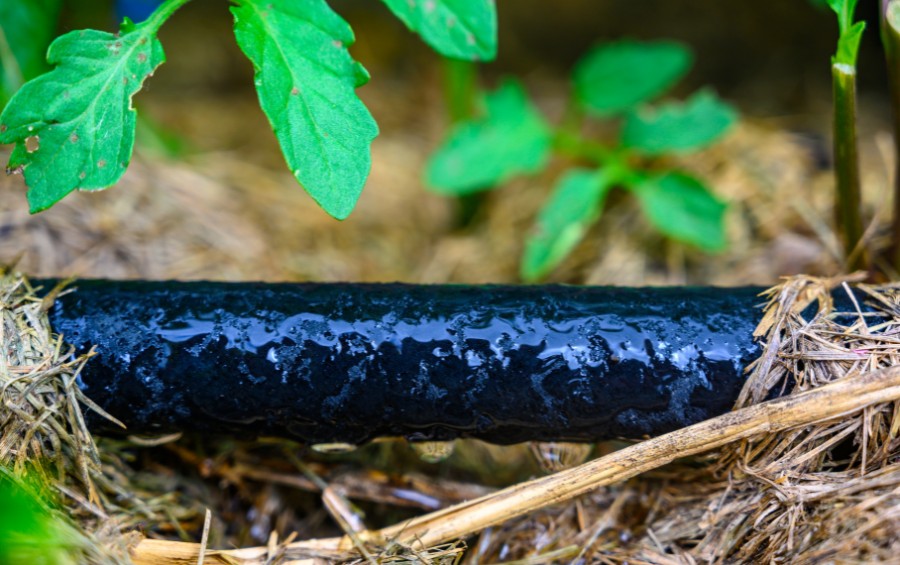The Importance of Deep Watering for Kansas City Trees

Think your trees are getting enough water? Maybe not. Discover why deep watering is key to helping Kansas City trees survive heat, drought, and decline.
Kansas City’s summer weather can be unpredictable. What starts as a mild, pleasant season can quickly shift into weeks of intense heat and little rainfall. When those dry spells hit, shallow watering from sprinklers isn’t enough to keep trees healthy. Deep watering is the best way to get them the water they need to survive when a harsh weather hits.
Key Takeaways
- Deep watering encourages tree roots to grow deeper underground (around two feet) rather than staying shallow near the surface, making trees more stable and better able to find water and nutrients.
- Slow, deep watering prevents water from evaporating quickly in summer heat and reduces soil runoff that can cause environmental pollution.
- High-pressure watering can cause soil compaction (especially problematic in Kansas City’s clay soil), restricting root growth and water absorption.
- Trees typically need about 10 gallons of water per inch of trunk diameter and using soaker hoses or irrigation systems helps prevent over- or underwatering.
- Young trees need frequent watering for root development, while mature trees only need supplemental watering during droughts, which can occur in both summer and winter in Kansas City.
Why Deep Watering Matters More Than You Think
We often remind homeowners to water their trees during a drought to help them bounce back from summer stress. But a quick spray from the garden hose isn’t going to cut it. To really make a difference, trees need deep watering. The problem is, many people aren’t sure what that means – or why it matters so much.

Deep Watering Encourages Roots to Grow Deeper
A tree uses its roots to bring up water and nutrients from the soil and transport them throughout its trunk, branches, and leaves to support growth and energy production. Roots will go where the water and nutrients are, as they are more likely to grow into areas with abundant resources.
Shallow watering will encourage the roots to congregate toward the top of the soil. Shallow roots will have a harder time finding water and nutrients for the rest of the tree, and they may end up exposed if they continue to grow in the upper six inches of the soil.
By getting the water deep in the soil, you help the roots grow down where they belong – about two feet underground. This not only helps them reach nutrients but also gives the tree stronger support, reducing the risk of uprooting during storms.
Shallow Water is the First to Evaporate in the Summer
If you only get the water to the highest portions of the soil, you risk much of it evaporating before the tree can use it. Watering low and slow will get the water to the deeper parts of the soil where it is less likely to evaporate before the roots can take it in.
Another way to reduce the risk of all your hard work evaporating along with the water is to provide hydration to your tree as early as possible. Get up early in the morning and do your watering first thing, as peak evaporation typically occurs between 10 a.m. and 5 p.m.
Deep Watering Avoids Potential Runoff
Slow and deep tree watering avoids the risk of soil runoff, which is more common when someone tries to speed the process up. This is why we always suggest using a soaker hose or irrigation system to slowly deliver the water to your yard over time, rather than all at once with a high-pressure hose attachment.
Soil runoff is a significant environmental problem, as it can carry fertilizer, insecticides, and more into nearby rivers and streams, causing pollution. Trees help reduce soil erosion when they have expansive roots, making proper watering all the more critical.
Deep Watering Can Prevent Potential Soil Compaction
Spraying your soil with a high-powered hose can lead to soil compaction. Compaction is a serious problem, as it can impact the roots’ ability to expand and find new sources of water and nutrients. It is even more of a problem in the Kansas City area, as we have clay soil that is prone to compaction.
Watering low and slow lets moisture soak in deeply without compacting the soil.
Watering Slowly Limits the Risk of Over- or Underwatering
While it is vital to water your trees, especially those that are young or going through a drought, ensuring you get the right amount of water to them is just as essential. Trying to get all your watering done quickly can make it difficult to know how much hydration your trees are getting.
Using a soaker hose and allowing it to water the trees over hours will enable you to better control how many gallons of water are going into the soil. In general, the rule of thumb for trees is 10 gallons of water per inch of trunk diameter. Overwatering can harm the roots and prevent them from getting adequate oxygen.
Frequently Asked Questions About Deep Watering in Kansas City
We know that watering isn’t the first thing on everyone’s mind when it comes to tree care, but it is a vital thing to do for your trees. If you want to learn more about the importance of watering, we’ve answered some of the common questions homeowners have about how to do it.
When do I need to water my trees?
We recommend watering young trees frequently to encourage wide root growth. Mature trees often do not need supplemental water during normal circumstances. However, during a drought, we recommend providing supplemental water to all your trees.
How can I perform deep watering for my trees?
The most efficient way to perform deep watering for your trees is to use an irrigation system. These systems allow you to control the quantity of water your trees get. If you don’t feel comfortable setting up an irrigation system, use a soaker hose instead. These hoses slowly deliver water to your soil, providing hydration below the surface.
What are the signs of a drought-stressed tree?
Some of the symptoms of a drought-stressed tree include:
- Wilting leaves
- Curling leaves
- Premature leaf drop
- Bark cracks
- Yellowing leaves
What are other things you should do for a drought-stressed tree besides watering?
Besides watering, we recommend checking the mulch around your tree during a drought. Mulch can help the soil retain moisture and regulate its temperature. However, keep the layer light to avoid suffocating the roots and preventing water from getting to the soil.
Is drought only a problem in Kansas City during the summer?
No, winter droughts are also common in our area and be just as damaging to your trees. As part of your winter tree care routine, we recommend watering during dry spells, as long as the ground is not frozen.

Worried About Your Tree’s Health This Summer? Arbor Masters Can Help!
Droughts can hit at any time in Kansas City, and if you aren’t prepared, your trees can suffer the consequences. Deep watering can help support your trees through the worst weather conditions and protect them from long-term damage. Trees that are generally healthy are more drought resistant than ones that are already stressed. If you’re worried about your trees and their condition, the Arbor Masters team can help.
Our professional team offers tree preservation services that can help keep your trees healthy and thriving year round. And when a drought hits, you’ll be prepared to care for them with deep watering to help through the dry weather. Call us today at 816-524-3131 or request a quote online.
Sorry, we couldn't find any posts. Please try a different search.

Get the latest local news, tree care tips, special offers, and company updates directly to your inbox! It's easy to subscribe and there's no spam - we promise.
"*" indicates required fields

